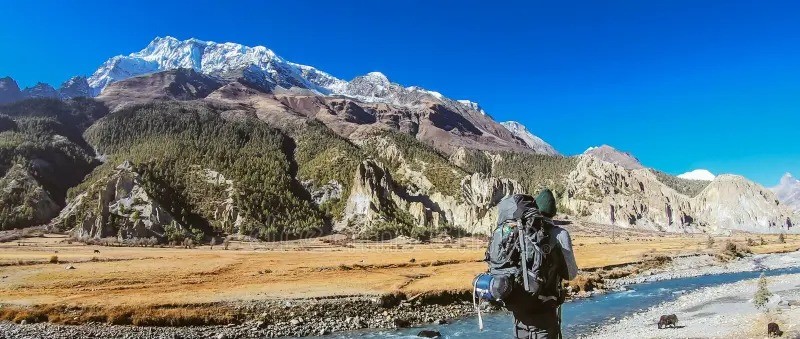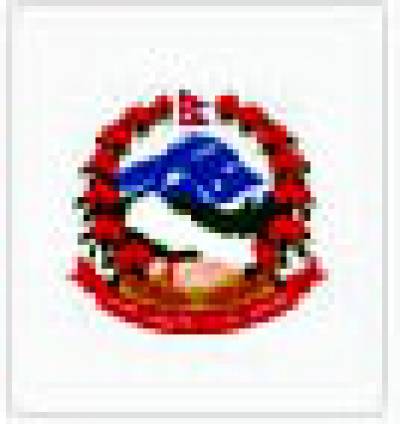ANNAPURNA CIRCUIT TILICHO LAKE POON HILL TREK 12 DAYS FROM POKHARA
The Annapurna Circuit Tilicho Lake Ghorepani Poon Hill Trek is an incredible 12-day adventure that takes trekkers through some of the most stunning landscapes in Nepal. Starting from Pokhara, the journey begins with a scenic drive to Besisahar, followed by a local shared jeep ride to Chame, the first stop on the trek. From Chame, you’ll start the trek through beautiful villages, lush forests, and awe-inspiring mountain views as you make your way towards Pisang and Manang, the latter being a popular stop for acclimatization.
Once in Manang, you’ll spend a rest day to adjust to the increasing altitude, which is essential for safely tackling higher elevations. During this rest day, you can explore the village, visit the Manang Monastery, or take a short hike to Ice Lake for magnificent panoramic views of the surrounding peaks.
The adventure continues with a trek to Tilicho Base Camp, followed by the highlight of the trek: a visit to Tilicho Lake, one of the highest lakes in the world at an altitude of 4,920 meters. After soaking in the breathtaking views of the lake and surrounding mountains, you’ll return to Shree Kharka and continue onward to Yak Kharka before arriving at Thorong Phedi. Here, you’ll prepare for the ultimate challenge – crossing the Thorong La Pass at 5,416 meters, one of the highest trekking passes in the world. After reaching the pass, you will descend to Muktinath, a sacred site for both Hindus and Buddhists.
The final part of the journey includes a trek to Ghorepani, where you’ll hike to the famous Poon Hill to witness a stunning sunrise over the Annapurna and Dhaulagiri mountain ranges. From there, you’ll trek down to Nayapul and take a local bus back to Pokhara, bringing this unforgettable 12-day trek to a close. This journey combines natural beauty, cultural richness, and a sense of accomplishment that will stay with you long after you’ve returned home.
ITINERARY
Day 1 : Drive from Pokhara to Chame (2,710 m/8,890 ft) – Duration: 8-9 hours.
Your journey begins with an exciting drive from Pokhara to Chame. The road winds through scenic landscapes, passing small villages, lush forests, and terraced fields, all with stunning views of the Annapurna and Manaslu mountain ranges. This long drive prepares you for the adventure ahead as you approach the starting point of your trek.
Day 2 : Trek to Pisang (3,115 m/10,200 ft) – Duration: 4-5 hours.
Today, you start your trek from Chame, heading towards Pisang. The trail ascends gradually through pine forests, crossing several suspension bridges and offering great views of the Himalayas. You'll pass by traditional Nepali villages and eventually reach Pisang, where you'll spend the night surrounded by dramatic mountain scenery.
Day 3 : Trek to Manang (3,540 m/11,300 ft) via Ngawal village – Duration: 6-7 hours.
On this day, the trek continues from Pisang to Manang. The trail passes through Ngawal village, a beautiful Tibetan settlement, before climbing further to Manang. As you walk, you’ll enjoy panoramic views of the Annapurna range and the surrounding peaks. Upon reaching Manang, you'll have time to relax and acclimatize.
Day 4 : Rest Day at Manang.
This is a vital rest day for acclimatization. Manang sits at an altitude of 3,540 meters, and it's important to let your body adjust to the high altitude. You can explore the village, visit the Manang Monastery, or take a short hike around the area for spectacular views of the Himalayas.
Day 5 : Trek from Manang to Tilicho Base Camp (4,150 m) – Duration: 5-6 hours.
Today’s trek takes you from Manang to Tilicho Base Camp. As you gain altitude, the terrain becomes more rugged and barren, with stunning views of the surrounding peaks. The trek is moderately difficult, and the air becomes thinner, so it’s important to take it slow and steady. You'll spend the night at Tilicho Base Camp, resting before your visit to the iconic Tilicho Lake.
Day 6 : Hike to Tilicho Lake (4,920 m) & Return to Base Camp & Trek to Shree Kharka – Duration: 7-8 hours.
An early start today as you hike up to Tilicho Lake, one of the highest lakes in the world at 4,920 meters. The views are absolutely mesmerizing, with crystal-clear waters surrounded by towering peaks. After exploring the lake, return to Tilicho Base Camp and continue trekking towards Shree Kharka, where you'll rest for the night.
Day 7 : Trek from Shree Kharka to Yak Kharka (4,200 m) – Duration: 5-6 hours.
Today’s trek takes you through the high-altitude terrain to Yak Kharka, a small settlement that serves as a stopover for trekkers. The trail is dotted with alpine vegetation and offers stunning views of the surrounding mountains. You’ll have the opportunity to rest and enjoy the peace of this remote location.
Day 8 : Trek from Yak Kharka to Thorong Phedi (4,500 m) – Duration: 3-4 hours.
This relatively short trek takes you from Yak Kharka to Thorong Phedi, the last stop before tackling Thorong La Pass. The trail gradually ascends as you get closer to the high pass, passing through alpine meadows. It's a good idea to rest and prepare for the challenging day ahead.
Day 9 : Trek from Thorong Phedi via Thorong La Pass (5,416 m) to Muktinath (3,802 m) – Duration: 7-9 hours.
Today is the most challenging day of the trek. You’ll wake up early to tackle the Thorong La Pass at an altitude of 5,416 meters. The ascent is steep, but the views from the top are absolutely worth the effort. After crossing the pass, the descent to Muktinath is long but manageable. Muktinath is a sacred pilgrimage site for both Hindus and Buddhists, and you’ll have the chance to visit its famous temple and enjoy the spiritual atmosphere.
Day 10 : Drive from Muktinath to Tatopani (1,200 m) – Duration: 6-7 hours.
From Muktinath, you will drive to Tatopani in a local jeep. This is a long journey, but it offers scenic views of the lower valleys and the lush vegetation that you didn’t see earlier in the trek. Tatopani is known for its natural hot springs, and you can relax in the warm waters after the long day of travel.
Day 11 : Trek from Tatopani to Ghorepani (2,860 m) – Duration: 7-8 hours.
After a refreshing rest at Tatopani, you’ll trek towards Ghorepani. The trail takes you through charming villages, terraced fields, and dense forests. The ascent is gradual but steady, and once you reach Ghorepani, you’ll be treated to stunning views of the Annapurna and Dhaulagiri mountain ranges.
Day 12 : Hike to Poon Hill (3,210 m) & Trek to Nayapul & Drive to Pokhara (850 m) – Duration: 7-9 hours.
On your final day, you’ll wake up early to hike to Poon Hill for an unforgettable sunrise view. The panoramic vista of the Himalayan peaks at dawn is a perfect way to end your trek. After taking in the views, you’ll descend to Nayapul and drive back to Pokhara, where your adventure comes to an end.
SERVICES
Cost Included in Your Package
- Drive from Pokhara to Besisahar by local bus and Besisahar to Chame by local shared Jeep.
- Drive from Muktinath to Tatopan by local bus & Nayapul to Pokhara by private car at the end of the trek.
- Tea House/Lodge accommodation during the trek.
- Three meals a day (Breakfast, Lunch, and Dinner) are provided throughout the trek.
- Experienced and qualified trek leader (guide) with a government license, and an assistant trekking guide for groups of 8 or more trekkers.
- Porter service: One porter for every two trekkers to help carry your luggage.
- Porters' coverage: Their salary, food, accommodation, insurance, and safety equipment.
- The Annapurna Conservation Area Permit (ACAP) fee is included.
- The Trekkers Information Management System (TIMS) card fee is covered.
- Use of trekking gear: Sleeping bag, down jacket, duffel bag, and walking poles (if you don't have your own), to be returned after the trek.
- Assistance with emergency rescue operations (funded by your travel insurance) in case of severe health conditions.
- Sherpa Expedition and Trekking appreciation certificate after completing the trek.
- Oxygen meter to check your pulse, oxygen saturation, and heart rate twice daily, ensuring your health and safety during the trek.
Cost Not Included in Your Package
- International Flight to and from Nepal.
- Nepal entry visa fee: Visas can be obtained easily on arrival at Tribhuvan International Airport, Kathmandu. The fees are as follows:
- $30 USD for a 15-day visa
- $50 USD for a 30-day visa
- $125 USD for a 90-day visa
- Accommodation and meals in Pokhara (other than those provided during the trek).
- Extra night accommodation in Kathmandu or Pokhara due to early arrival, late departure, or early return from trekking for any reason outside the scheduled itinerary.
- Personal expenses such as shopping, snacks, bar bills, tea, coffee, hot water, bottled or boiled water, shower fees, Wi-Fi, laundry, telephone calls, battery recharges, extra porters, etc.
- Personal clothing and gear not provided in the package.
- Travel insurance: It is strongly recommended to have insurance that covers trekking in high-altitude areas.
- Tips for your guide and porters, which is customary in Nepali culture.
- Additional costs or delays caused by circumstances beyond our control, such as landscape changes, bad weather, itinerary modifications for safety, illness, changes in government policy, political instability, strikes, or other unforeseen events.
- NOTE: If you return earlier from the trek due to sickness or any other reason, expenses for flights, hotels, meals, and other services are nonrefundable. You will be responsible for any additional costs incurred in Kathmandu or Pokhara.
EQUIPMENTS
The following information will give you some idea about what you need to bring for the trek. It is important you do not forget the essential items, as this will determine your comfort and safety on the trek. Equally important is that you do not burden yourself with unnecessary equipment on the trek.
- Sleeping Bag (Sherpa Teams will provide but need to return after completing the trip)
- Duffel Bag (Sherpa Teams will provide but need to return after completing the trip)
- Fleece jacket or pullover
- Waterproof windbreaker or windcheater
- Thermal underclothes
- Rain poncho
- Down jacket (Sherpa Teams will provide but need to return after completing the trip)
- Fleece or wool trousers
- Sun hat or scarf
- Trekking pants (two pairs)
- Mittens or woolen gloves
- Hiking socks (several pairs)
- Moisture-wicking shirts, including t-shirts
- Trekking shoes or boots with spare laces
- Flip-flops or sandals for relaxing in the evenings
- Underwear (several pairs)
- Swimsuit or swimming costume
- Sunglasses
- Headlamp or flashlight/torch
- Sleeping bag (Sherpa Teams can provide this for you)
- Trekking poles (if desired)
- Hiking backpack with a capacity of at least 40 liters
- Small lock for your backpack
- Reusable water bottles (at least two liters)
- Water purification tablets or filtration device
- Wash towel
- Basic first aid kit
Toiletries (tissues, toilet paper, moisturizer, lip balm, sunscreen, sanitary pads, hand sanitizer, nail clippers, a small mirror, toothbrush, toothpaste, glasses, contacts, etc.)
GOOD TO KNOW
🚶♂️ Trekking Difficulty
The Annapurna Circuit Tilicho Lake Ghorepani Poon Hill Trek is a challenging trek that requires a good level of physical fitness and previous trekking experience. Trekkers will experience varying altitudes and terrain, from steep climbs to high-altitude passes. It is important to be prepared for long days of walking and high-altitude conditions. Adequate rest, hydration, and acclimatization are essential for a safe trek.
🏞️ Scenic Beauty
This trek offers some of the most breathtaking landscapes in the world. From lush subtropical forests to the barren high-altitude terrain, trekkers will pass through a wide variety of environments. The views of the Annapurna and Dhaulagiri mountain ranges, along with stunning vistas of Tilicho Lake and Thorong La Pass, provide the perfect backdrop for your journey.
🌍 Cultural Experience
As you trek through various villages, you’ll have the opportunity to immerse yourself in the culture of the Tibetan and Nepali communities. The trek passes through traditional villages like Manang and Pisang, where you’ll encounter ancient monasteries, yak herders, and local customs. Visiting Muktinath, a sacred pilgrimage site for Hindus and Buddhists, offers a spiritual aspect to the trek.
🧳 What to Pack
When preparing for the Annapurna Circuit Tilicho Lake Ghorepani Poon Hill Trek, packing the right gear is crucial. Make sure to bring a good pair of trekking boots, warm clothing for higher altitudes, a sleeping bag, a rain jacket, and sufficient snacks. A hydration system, trekking poles, and a well-fitted backpack are also recommended for comfort and safety. Don’t forget a good camera to capture the stunning scenery!
🌄 Best Time to Trek
The best time to undertake the Annapurna Circuit Tilicho Lake Ghorepani Poon Hill Trek is during the pre-monsoon (March to May) and post-monsoon (September to November) seasons. These months offer clear skies, mild weather, and excellent views of the mountains. Trekking in the winter months can be too cold, and the summer months are prone to heavy rainfall.
🏥 Health & Safety
Since this trek reaches altitudes of over 5,000 meters, altitude sickness is a risk. It is crucial to acclimatize properly and take rest days to help your body adjust to the changing altitude. Hydration is key, so always carry plenty of water and drink regularly. Additionally, carrying a first aid kit with basics like bandages, painkillers, and blister treatments is highly recommended.
🚌 Transportation Details
The trek begins with a drive from Pokhara to Besisahar and continues by shared jeep to Chame, where the trek begins. After completing the trek, you’ll return to Pokhara via a local bus from Muktinath. The drive offers a great opportunity to witness the changing landscapes as you descend from the mountain regions back to the city.
🌍 Altitude Considerations
As the trek reaches high altitudes, proper acclimatization is essential to avoid altitude sickness. Altitudes reach over 5,000 meters at Thorong La Pass and Tilicho Lake, so trekkers should take it slow and spend extra time at acclimatization points like Manang. Staying hydrated and eating well will also help your body adjust to the high altitudes.
🏠 Teahouses & Accommodation
Throughout the trek, trekkers will stay in teahouses, basic lodges, or guesthouses, which provide food and accommodation along the route. These simple accommodations offer a warm bed and shelter, but it’s important to note that they may not have the same comfort level as hotels in larger cities. Some teahouses also provide hot showers and internet access, but it can be limited in more remote areas.
⏳ Duration of the Trek
This trek lasts 12 days, providing enough time to explore each area, acclimatize, and enjoy the surroundings. While some trekkers may opt for a shorter or longer version, 12 days allows for a comfortable pace, making sure you have enough time to experience the stunning views, interact with locals, and properly acclimatize to the high altitude.
MAP
PHOTOS/Videos
Departures
Select a departure month
Fill out the form below and a Travel Expert will reach out to create your perfect tour.
FAQS
What is the difficulty level of the trek?
The Annapurna Circuit Tilicho Lake Ghorepani Poon Hill Trek is considered a challenging trek. It requires a good level of fitness and stamina, as trekkers will be walking for several hours each day, covering varied terrain and high-altitude regions. Acclimatization days are essential to adjust to the elevation, especially when crossing Thorong La Pass.
What is the best time to trek?
The best times to undertake this trek are during the pre-monsoon (March to May) and post-monsoon (September to November) seasons. These months offer the clearest skies, moderate temperatures, and optimal trekking conditions. The summer months (June to August) are the monsoon season, and trekking during this time is not recommended due to heavy rainfall.
How high does the trek reach?
The highest point of the trek is Thorong La Pass, which stands at an altitude of 5,416 meters. Other high-altitude spots include Tilicho Lake at 4,920 meters. Proper acclimatization is crucial to avoid altitude sickness.
Do I need previous trekking experience?
While it’s not necessary to have prior trekking experience, it’s highly recommended to have some physical fitness and basic hiking knowledge. The trek involves steep ascents and descents, so being in good shape will make the experience more enjoyable and manageable.
How long does the trek take?
The trek typically takes 12 days. This includes travel days, acclimatization days, and days for trekking between key destinations. The trek is divided into manageable segments to ensure a safe and rewarding experience.
Are there places to stay along the trek?
Yes, the trek is supported by teahouses, basic lodges that provide accommodation and meals along the way. These teahouses are simple but comfortable, offering a warm place to rest and traditional Nepali food.
What type of food can I expect?
During the trek, you’ll be able to enjoy traditional Nepali food, such as dal bhat, momos, and noodles, as well as some western options like pasta and fried rice. The higher you go, the food options may become more limited. It’s important to stay hydrated and eat regularly to help with acclimatization.
How do I prepare for the trek?
To prepare for this trek, it’s recommended to engage in regular cardiovascular exercise like hiking, running, or cycling for several months before departure. Strengthening your legs and core muscles will also be beneficial. Packing warm, moisture-wicking clothes and gear suited for high-altitude trekking is essential.
Is altitude sickness a concern?
Altitude sickness is a common issue on high-altitude treks like this one. To minimize risks, the trek includes rest days for acclimatization, such as in Manang. It's crucial to listen to your body, drink plenty of water, and inform your guide if you experience symptoms of altitude sickness.
How do I get to the starting point of the trek?
You can reach the starting point of the trek by taking a local bus from Pokhara to Besisahar, followed by a jeep ride to Chame. These buses and jeeps are regular and affordable, making them easy transportation options for trekkers.
Latest Traveller’s Reviews
Travel experiences of our clients who recently returned from their trips.
100%
Based On 5428 Reviews
Marcel Mastenbroek
Netherlands
April 9, 2025
Beautiful adventure
My brother and I had a great trip to the Everest Base Camp. Together with Santa our very well informed gide, who took care of us in a fantastic way and gave us much information during the hike, and Gulzen our porter (who carried each day our two bags of 10kg each plus his own bag....unbelievable). We had a wonderful time in the beautiful Himalayas, it was a lifetime experience!
Isabelle Fournier
Belgium
April 3, 2025
Incredible Journey With a True Legend
The Everest Three Pass Trek is hands-down the most beautiful and challenging trek I’ve ever done, and it was made unforgettable by our amazing guide, Pem Dorje Sherpa, from Sherpa Expedition & Trekking. Pem Dorje is a legend in every sense—calm, wise, strong, and full of stories. He knew the trails inside out and constantly kept us motivated, safe, and smiling. From the glacier crossings of Cho La to the dramatic views from Gokyo Ri, he made every moment special. One day, I struggled with altitude headaches, and Pem Dorje immediately adjusted our plan, gave me warm soup, and walked beside me at my pace. That level of care made all the difference. The trail itself is pure magic—massive peaks, prayer flags fluttering in the wind, quiet Sherpa villages, and stunning alpine lakes. We even spotted musk deer and Himalayan pheasants! Sherpa Expedition handled everything professionally, from airport pickup to gear checks. The porters were kind and efficient, and we had zero logistical issues. If you want to push yourself while being fully supported by a kind, knowledgeable guide, ask for Pem Dorje. You’ll finish stronger than you ever imagined—and happier, too.
Isabella Martinez
Australia
April 1, 2025
Sherpa-Led Magic in the Mountains – Guided by Tsering Phurba Sherpa
To say that the Everest Three Pass Trek was life-changing would be an understatement. The stunning peaks, vast glaciers, and kind people left an imprint on my soul. But what truly made the trek magical was Tsering Phurba Sherpa, our incredible guide from Sherpa Expedition & Trekking. Tsering was full of joy, laughter, and strength. He was a motivator and a protector—always keeping an eye on our group, adjusting our itinerary when needed, and celebrating every little win with us. I remember the cold mornings and long days, and how Tsering always had hot tea or a snack ready when we needed it most. His care was beyond professional—it felt personal. He even helped me with my backpack straps to ease shoulder strain, and gave away his spare headlamp to someone who lost theirs. The trek itself was everything I hoped for—raw, rugged, and rewarding. We hiked through snow, ice, rock, and forest. The Gokyo Lakes glowed like crystals, and Everest from Kala Patthar was overwhelming. Sherpa Expedition created the perfect balance between challenge and care. If you want to do this trek right, go with them—and ask for Tsering Phurba. You won’t regret it.
People Considering This Package Right Now Check availability






















